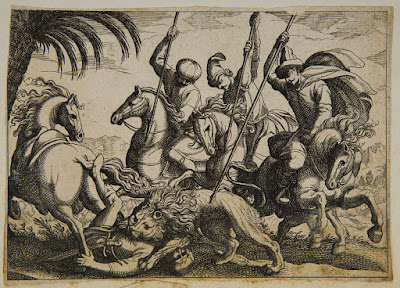 |
| Enamel lion bonbonnière, c. 1760-70. Sold at Bonham's in 2011 for £2,750. Originally from the Mort & Moira Lesser collection, and before that, the Ionides Collection. |
Box 1
This beautifully painted lion's head was used as a bonbonnière (sweet box) in the late 1700s. It was made in Birmingham or Bilston, or possibly Wednesbury, and is a particularly fine example. Similar boxes for other big cats, such as tigers and leopards, were made but the copper base of the box is raised around the mane, suggesting that this box was designed from start to finish as a lion. The mane and fur are painted in delicate lines in multiple shades of yellow and brown and his whiskers and teeth are particularly endearing.
The lid (see below) was painted with an image of Sampson grappling with a lion. The lid is hinged and mounted simply.
Box 3
This box, in a private collection, is moulded in a very similar way to one held at Wolverhampton Museum (below), but the base is given a grassy effect, and the lion itself painted in a vibrant orange.
Bernard Watney and R J Charleston, 'Petitions for Patents'.
The lid (see below) was painted with an image of Sampson grappling with a lion. The lid is hinged and mounted simply.
 |
| Lid of lion bonbonnière (above). 6.2cm diameter. |
Box 2
The lion below contains double compartments, possibly for sweets and snuff, or two different kinds of sweets, and the lid of each hinged section (see below again) was painted with leopards, one standing, and another being hunted.
Hunting scenes were popular on boxes of animals renowned for being hunted, such as big cats and boars, the scenes possibly inspired by prints produced by Antonio Tempesta (1555-1630), an Italian painter and engraver who produced dozens of hunting prints depicting men hunting both traditional and exotic animals with spears. The makers of these boxes often used popular prints such as these to inspire the designs on the lids.
 |
Enamel lion bonbonnière or snuff-box, c. 1760-5. Sold at Bonham's in 2011 for £4,000. Originally from |
 |
| Lid of above box. 11.2cm long. |
Hunting scenes were popular on boxes of animals renowned for being hunted, such as big cats and boars, the scenes possibly inspired by prints produced by Antonio Tempesta (1555-1630), an Italian painter and engraver who produced dozens of hunting prints depicting men hunting both traditional and exotic animals with spears. The makers of these boxes often used popular prints such as these to inspire the designs on the lids.
 |
| A Lion Hunt, with a Lion Killing a Man (c. 1620), by Antonio Tempesta. Harvard Art Museums Collection. |
Box 3
 |
| Lid of a lion bonbonnière from a private collection. This exact scene can be found on the lid of a tiger bonbonnière. |
 |
| Lion bonbonnière, c. 1780-95. Front. |
 |
| Lion bonbonnière, c. 1780-95. Back. |
Box 4
Another bonbonnière held at Wolverhampton Museum depicts a similar sleepy lion on a plain pale green base. Unlike the lion head, at the top of the page, the shaping of the copper base could have been used for other animals, including other wild cats, as well as dogs. This was probably of later manufacture.


